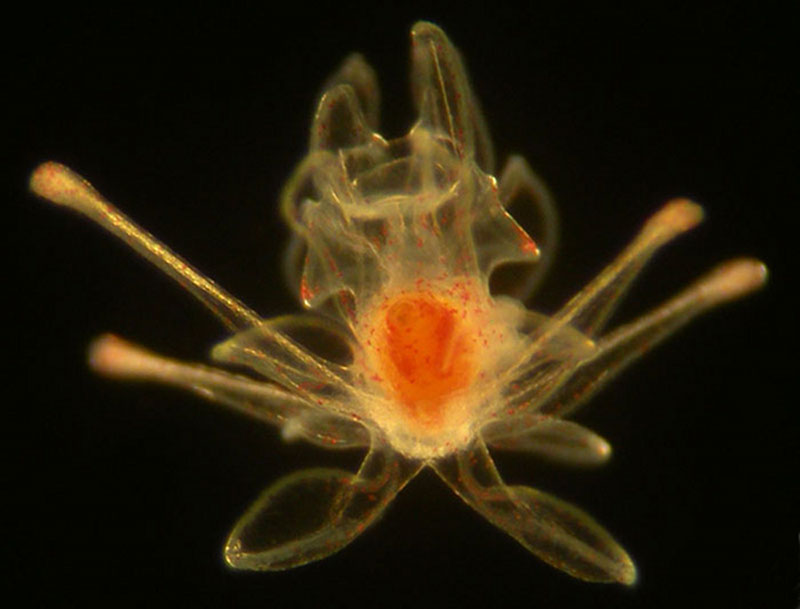
By Maya Watts, Post-doctoral Fellow - Oregon Institute of Marine Biology
May 24, 2013

Cidaroid (pencil) urchin collected with the Jason II remotely operated vehicle on NOAA Ship Ronald H. Brown. Image courtesy of Art Howard, Deepwater Canyons 2013 - Pathways to the Abyss, NOAA-OER/BOEM/USGS. Download larger version (jpg, 5.7 MB).
Today's dive covered a vast expanse of a turtled shipwreck. Littering the ship's hull and the surrounding soft sediment were many pencil urchins, named for their thick, pencil-like spines. While excited to see the gun turrets, frames, and boilers, for me the pencil urchins held the promise of producing larvae.
A larva is an early life history stage or, more simply, a distinct baby form that often looks nothing like the adult it will metamorphose into. For example, the pluteus larva of a sea urchin looks nothing like an adult urchin. But in order to get larvae, you first have to be able to get eggs and sperm. And as a larval biologist, I am always wondering what I can get to spawn for me.

Pluteus larva of Cidaris blakei. Image courtesy of Kathleen Bennett, University of Oregon. Download larger version (jpg, 326 KB).
So we used the Jason remotely operated vehicle to collect 15 of these pencil urchins around the wreck. Once Jason was back on deck, we moved the urchins to a chilled recirculating tank system to keep them alive and relatively happy. At the end of the cruise these urchins and seep mussels (Bathymodiolus childressi) collected earlier in the cruise will be shipped back to the lab for spawning.

Coelopluerus sp., urchin collected with the Jason II remotely operated vehicle on NOAA Ship Ronald H. Brown. Image courtesy of Liz Baird, Deepwater Canyons 2013 - Pathways to the Abyss, NOAA-OER/BOEM/USGS. Download larger version (jpg, 9.9 MB).
The pencil urchins are the second major herd of urchins we have run into on this cruise. During leg 1, scientists collected numerous Coelopluerus sp. that have already been shipped back to the lab for spawning. In contrast to the thick, stubby spines of the pencil urchins, Coelopluerus sp. have extremely long, thin spines and a beautiful red and green coloring.
Inducing urchins and mussels to spawn their eggs or sperm is less a matter of dimmed lights and soothing music and more of a chemical injection. Potassium chloride is injected into the urchins which causes their gametes to contract and release eggs or sperm, depending on the gender of the urchin. In the case of the mussels, seratonin (a neurotransmitter) causes egg maturation in females and spawning in both sexes. If we are lucky enough to get numerous males and females, we can fertilize the eggs with sperm and rear larvae in the lab.
But what can a larva tell us about life in the deep sea? And how can a tiny larva get from one patchy habitat (e.g., cold seep or hard substrate) to another across a mostly soft sediment ocean floor?
Most larvae of benthic invertebrates have planktonic larvae. Some larvae spend weeks to months feeding in the water column before settling down and metamorphosing (called planktotrophic larvae). Others do not feed and spend a short period of time in the water column before metamorphosis (called lecithotrophic larvae).
By raising larvae in the lab through metamorphosis, we can determine the larval period or planktonic larval duration (PLD). This PLD, combined with knowledge of the speed and direction of oceanic currents, can give us an estimate of maximum dispersal distance and trajectories and examine how these predictions relate to the biogeographic distribution of deep sea species.